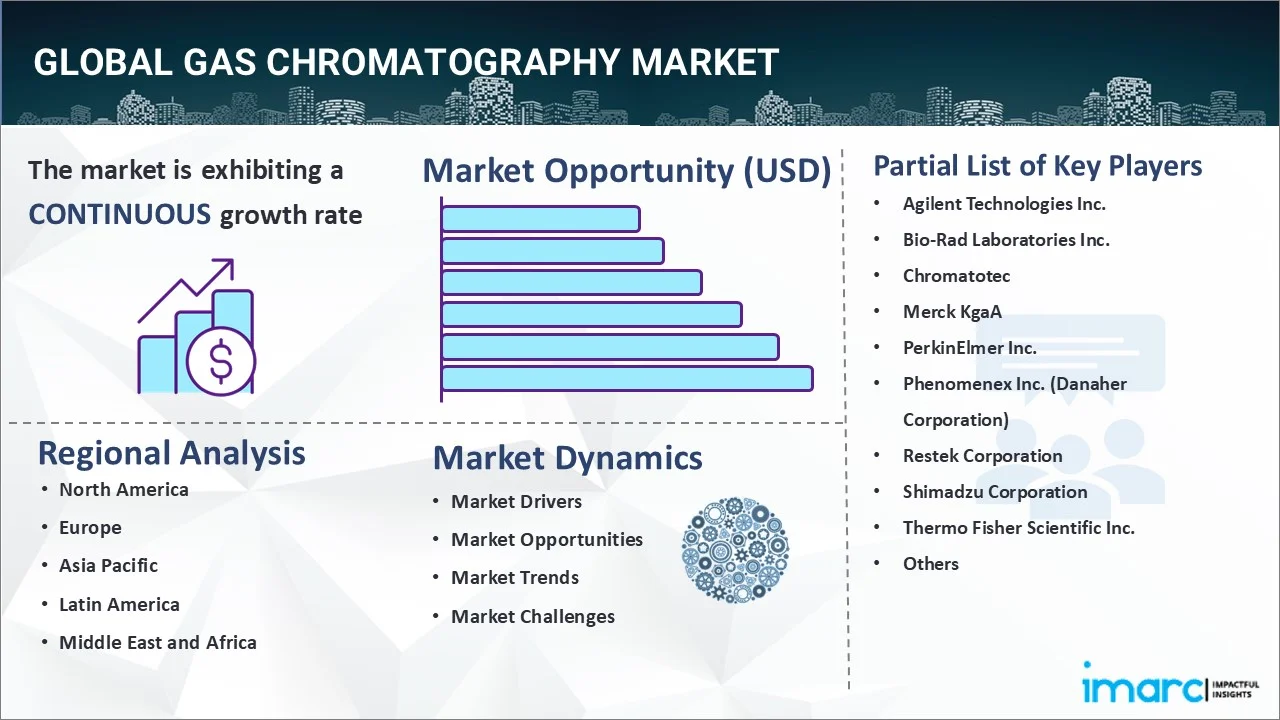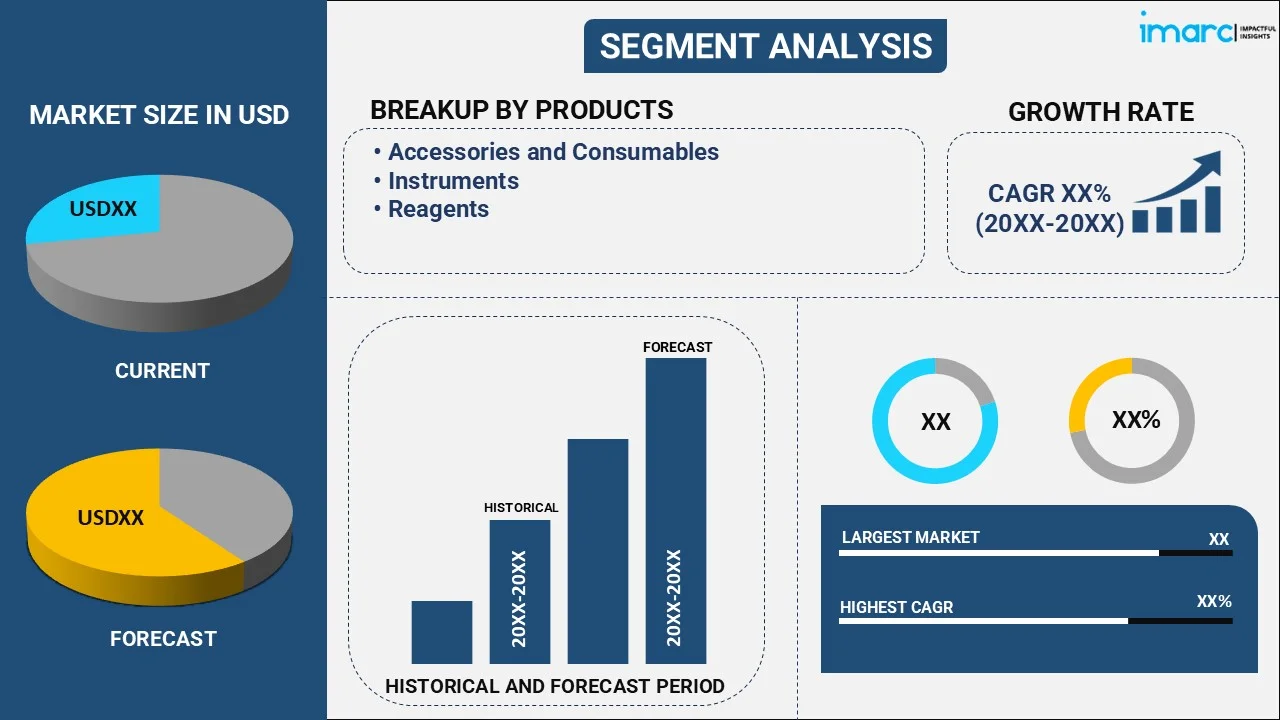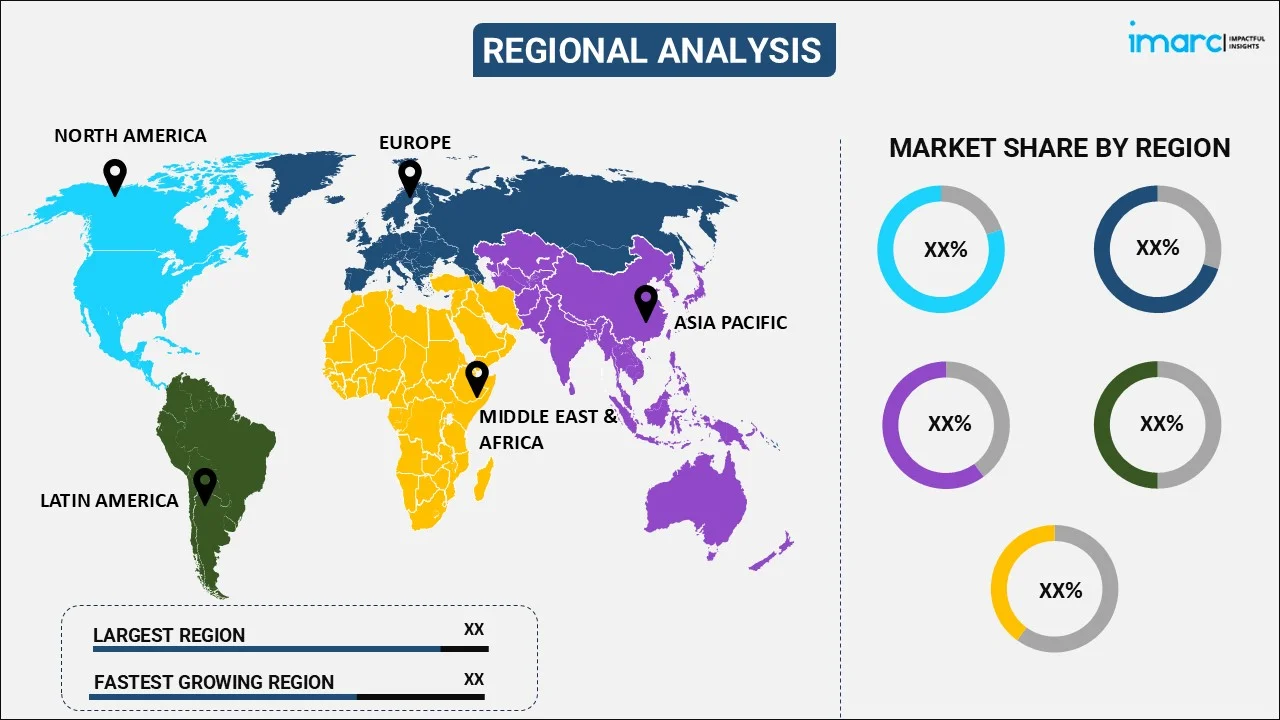
Gas Chromatography Market Report by Product (Accessories and Consumables, Instruments, Reagents), End Use Industry (Pharmaceutical, Oil and Gas, Food and Beverage, Agriculture, Environmental Biotechnology, and Others), and Region 2025-2033
Gas Chromatography Market Size:
The global gas chromatography market size reached USD 3.2 Billion in 2024. Looking forward, IMARC Group expects the market to reach USD 4.7 Billion by 2033, exhibiting a growth rate (CAGR) of 4.06% during 2025-2033. The ongoing advancements in technology, increasing demand for analytical testing in pharmaceuticals, environmental monitoring, forensic science, food safety, and biotechnology, and rising investments in research and development (R&D) and regulatory compliance are some of the major factors strengthening the market growth. At present, North America holds the largest market share, driven by stringent regulatory mandates and presence of leading manufacturers.
|
Report Attribute
|
Key Statistics
|
|---|---|
|
Base Year
|
2024
|
|
Forecast Years
|
2025-2033
|
|
Historical Years
|
2019-2024
|
| Market Size in 2024 | USD 3.2 Billion |
| Market Forecast in 2033 | USD 4.7 Billion |
| Market Growth Rate 2025-2033 | 4.06% |
Gas Chromatography Market Analysis:
- Major Market Drivers: The gas chromatography (GC) market is driven by advancements in technology, such as high-resolution columns and integrated mass spectrometry, enhancing accuracy and efficiency. In addition to this, the rising demand for analytical testing in pharmaceuticals, environmental monitoring, food safety, and biotechnology is contributing to the market growth.
- Key Market Trends: One of the major gas chromatography market trends is the ongoing technological innovations, including automation and improved data analysis software, which are significantly enhancing GC system capabilities. Moreover, increasing adoption in emerging markets and the growing focus on environmental testing and monitoring are providing an impetus to the gas chromatography market growth.
- Geographical Trends: North America enjoys the leading position in the GC market, driven by advanced technological infrastructure, extensive R&D activities, and stringent regulatory standards. Meanwhile, emerging markets in Asia-Pacific, Latin America, and Africa are experiencing rapid gas chromatography market growth due to industrialization and increasing regulatory requirements.
- Competitive Landscape: Some of the major market players in the gas chromatography industry include Agilent Technologies Inc., Bio-Rad Laboratories Inc., Chromatotec, Merck KgaA, PerkinElmer Inc., Phenomenex Inc. (Danaher Corporation), Restek Corporation, Shimadzu Corporation, Thermo Fisher Scientific Inc., W. R. Grace and Company, Waters Corporation., among many others.
- Challenges and Opportunities: The gas chromatography market overview shows that the high costs of advanced GC systems and the need for skilled operators pose significant challenges. However, opportunities arise from the expanding use of GC in diverse applications, such as food and beverage (F&B) safety and the growing demand for personalized medicine and environmental sustainability initiatives.

Gas Chromatography Market Trends:
Technological advancements
Innovations in column technology, detector sensitivity, and data analysis software are enhancing the efficiency, accuracy, and speed of GC systems. For example, the development of high-resolution columns makes it possible to separate complex mixtures more effectively, which enhances compound identification and quantification. Furthermore, improvements in detector technology, such as the integration of mass spectrometry (MS) with gas chromatography (GC) systems, have raised the analytical sensitivity and specificity, making it possible to identify traces of pollutants. Additionally, improvements in automation and sample preparation techniques are reducing manual intervention, minimizing errors, and increasing throughput. The integration of advanced software for data analysis and interpretation is also streamlining workflows, making GC systems more user-friendly and accessible to a broader range of users, including those in academic and industrial research settings, aiding the gas chromatography market growth.
Increasing adoption of GC in emerging market
Countries in Asia-Pacific, Latin America, and Africa are experiencing rapid industrialization and urbanization, leading to a surge in demand for analytical testing across various sectors. In these regions, the pharmaceutical, biotechnology, F&B, and petrochemical industries are expanding, creating a substantial need for accurate and efficient analytical techniques like GC. Additionally, governments and regulatory bodies in these emerging markets are also tightening regulations related to environmental protection, food safety, and drug quality, further driving the adoption of GC systems. Moreover, rising investments in healthcare infrastructure and R&D activities in these regions are boosting the demand for advanced analytical instruments, including GC. The growing awareness of the benefits of GC, coupled with increasing purchasing power and improving technological infrastructure, is making these markets attractive for manufacturers and suppliers thereby impelling the gas chromatography demand.
Growing emphasis on environmental testing and monitoring
With rising concerns about environmental pollution and its impact on public health, there is a heightened focus on monitoring air, water, and soil quality. GC is a vital tool for analyzing volatile organic compounds (VOCs), persistent organic pollutants (POPs), pesticides, and other hazardous substances in environmental samples. Regulatory agencies worldwide are enforcing stricter environmental standards and guidelines, necessitating regular monitoring and analysis using advanced techniques like GC. For instance, the U.S. Environmental Protection Agency (EPA) and the European Environment Agency (EEA) have established stringent regulations for the detection and quantification of environmental pollutants. Furthermore, the gas chromatography market report encourages the adoption of green and sustainable practices in GC systems to monitor and control emissions and ensure compliance with environmental standards. The increased focus on environmental sustainability and public health thus significantly bolstering the GC market.
Gas Chromatography Market Segmentation:
IMARC Group provides an analysis of the key trends in each segment of the market, along with gas chromatography market forecast at the global, regional, and country levels for 2025-2033. Our report has categorized the market based on product and end use industry.
Breakup by Product:

- Accessories and Consumables
- Columns and Accessories
- Fittings and Tubing
- Auto-sampler Accessories
- Flow Management and Pressure Regulator Accessories
- Others
- Instruments
- Systems
- Auto-samplers
- Fraction Collectors
- Detectors
- Flame Ionization Detectors (FID)
- Thermal Conductivity Detectors (TCD)
- Mass Spectrometry Detectors
- Others
- Reagents
- Analytical Gas Chromatography Reagents
- Bioprocess Gas Chromatography Reagents
Accessories and Consumables account for the majority of the market share
The report has provided a detailed breakup and analysis of the market based on the product. This includes accessories and consumables (columns and accessories, fittings and tubing, auto-sampler accessories, flow management and pressure regulator accessories, and others), instruments (systems, auto-samplers, fraction collectors, and detectors (flame ionization detectors (FID), thermal conductivity detectors (TCD), mass spectrometry detectors, and others)), and reagents (analytical gas chromatography reagents and bioprocess gas chromatography reagents). According to the report, accessories and consumables represented the largest segment.
Accessories and consumables account for the majority of the share in the gas chromatography market segmentation due to their essential role in the operation and maintenance of GC systems. These items include columns, syringes, vials, filters, and detectors, which are critical for ensuring accurate and efficient chromatographic analysis. Columns need regular replacement to maintain performance and accuracy. Also, consumables such as carrier gases, septa, and liners are frequently used and need periodic replenishment. The recurring nature of these purchases creates a steady and significant revenue stream for suppliers. As the demand for high-precision analytical testing in various industries grows, so does the need for these consumables and accessories, further creating a positive gas chromatography market outlook.
Breakup by End Use Industry:
- Pharmaceutical
- Oil and Gas
- Food and Beverage
- Agriculture
- Environmental Biotechnology
- Others
Food and beverage hold the largest share of the industry
A detailed breakup and analysis of the market based on the end use industry have also been provided in the report. This includes pharmaceutical, oil and gas, food and beverage, agriculture, environmental biotechnology, and others. According to the report, food and beverage accounted for the largest market share.
The food and beverage industry holds the largest gas chromatography market share due to the critical need for accurate and comprehensive testing of food products for safety, quality, and compliance with regulatory standards. GC is widely used to detect and quantify contaminants, pesticides, additives, and flavor compounds in F&B, ensuring they are safe for consumption and meet quality specifications. The increasing complexity of food supply chains and the heightened focus on food safety regulations globally drive the demand for advanced GC techniques. Along with this, the growing consumer awareness and demand for transparency in food labeling and ingredients further propel the use of gas chromatography market value, making it a pivotal tool for ensuring product integrity and safety.
Breakup by Region:

- North America
- United States
- Canada
- Asia-Pacific
- China
- Japan
- India
- South Korea
- Australia
- Indonesia
- Others
- Europe
- Germany
- France
- United Kingdom
- Italy
- Spain
- Russia
- Others
- Latin America
- Brazil
- Mexico
- Others
- Middle East and Africa
North America leads the market, accounting for the largest gas chromatography market share
The report has also provided a comprehensive analysis of all the major regional markets, which include North America (the United States and Canada); Asia Pacific (China, Japan, India, South Korea, Australia, Indonesia, and others); Europe (Germany, France, the United Kingdom, Italy, Spain, Russia, and others); Latin America (Brazil, Mexico, and others); and the Middle East and Africa. According to the report, North America represents the largest regional market for gas chromatography.
Gas chromatography market analysis revealed North America as the leading region owing to its advanced technological infrastructure, extensive R&D activities, and stringent regulatory standards across various industries. The region is home to numerous pharmaceutical, biotechnology, F&B, and petrochemical companies that rely heavily on GC for analytical testing and quality control. Additionally, the presence of leading GC manufacturers fosters continuous innovation and availability of advanced GC systems and consumables. Strong governmental regulations related to environmental monitoring and food safety further drive the adoption of GC technologies. The robust academic and research institutions in North America also contribute to the high demand for sophisticated GC systems, solidifying the region's gas chromatography market size.
Competitive Landscape:
The market research report has also provided a comprehensive analysis of the competitive landscape in the market. Detailed profiles of all major companies have also been provided. Some of the major market players in the gas chromatography industry include:
- Agilent Technologies Inc.
- Bio-Rad Laboratories Inc.
- Chromatotec
- Merck KgaA
- PerkinElmer Inc.
- Phenomenex Inc. (Danaher Corporation)
- Restek Corporation
- Shimadzu Corporation
- Thermo Fisher Scientific Inc.
- W. R. Grace and Company
- Waters Corporation
(Please note that this is only a partial list of the key players, and the complete list is provided in the report.)
The competitive landscape of the GC market is characterized by the presence of several key players who are continually innovating to maintain and enhance their market positions. Gas chromatography companies focus on technological advancements, such as integrating mass spectrometry with GC systems and developing high-resolution columns and automated sample preparation systems to improve analytical accuracy and efficiency. Additionally, strategic collaborations, mergers and acquisitions, and expansions into emerging markets are common strategies employed to capture larger market shares. Smaller and regional players also contribute to the competitive dynamics by offering specialized and cost-effective solutions. The market is driven by ongoing demand in pharmaceuticals, environmental testing, F&B, and petrochemicals, ensuring sustained competition and innovation.
Gas Chromatography Market News:
- In September 2023, Shimadzu unveils the Brevis GC-2050, a compact gas chromatography system designed to maximize lab space without sacrificing performance. This versatile system supports additional headspace samplers, mass spectrometers, and other accessories. With a large GC oven accommodating two capillary columns, the Brevis GC-2050 enhances flexibility and efficiency for diverse analytical needs.
Gas Chromatography Market Report Scope:
| Report Features | Details |
|---|---|
| Base Year of the Analysis | 2024 |
| Historical Period | 2019-2024 |
| Forecast Period | 2025-2033 |
| Units | Billion USD |
| Scope of the Report | Exploration of Historical Trends and Market Outlook, Industry Catalysts and Challenges, Segment-Wise Historical and Future Market Assessment:
|
| Products Covered |
|
| End Use Industries Covered | Pharmaceutical, Oil and Gas, Food and Beverage, Agriculture, Environmental Biotechnology, Others |
| Regions Covered | Asia Pacific, Europe, North America, Latin America, Middle East and Africa |
| Countries Covered | United States, Canada, Germany, France, United Kingdom, Italy, Spain, Russia, China, Japan, India, South Korea, Australia, Indonesia, Brazil, Mexico |
| Companies Covered | Agilent Technologies Inc., Bio-Rad Laboratories Inc., Chromatotec, Merck KgaA, PerkinElmer Inc., Phenomenex Inc. (Danaher Corporation), Restek Corporation, Shimadzu Corporation, Thermo Fisher Scientific Inc., W. R. Grace and Company, Waters Corporation, etc. |
| Customization Scope | 10% Free Customization |
| Post-Sale Analyst Support | 10-12 Weeks |
| Delivery Format | PDF and Excel through Email (We can also provide the editable version of the report in PPT/Word format on special request) |
Key Benefits for Stakeholders:
- IMARC’s industry report offers a comprehensive quantitative analysis of various market segments, historical and current market trends, market forecasts, and dynamics of the gas chromatography market from 2019-2033.
- The research report provides the latest information on the market drivers, challenges, and opportunities in the global gas chromatography market.
- The study maps the leading, as well as the fastest-growing, regional markets. It further enables stakeholders to identify the key country-level markets within each region.
- Porter's five forces analysis assists stakeholders in assessing the impact of new entrants, competitive rivalry, supplier power, buyer power, and the threat of substitution. It helps stakeholders to analyze the level of competition within the gas chromatography industry and its attractiveness.
- The competitive landscape allows stakeholders to understand their competitive environment and provides insight into the current positions of key players in the market.
Key Questions Answered in This Report
The global gas chromatography market was valued at USD 3.2 Billion in 2024.
We expect the global gas chromatography market to exhibit a CAGR of 4.06% during 2025-2033.
The rising consumer preference towards gas chromatography, as it is cost-effective, reliable, and offers various benefits, such as accurate and quick separation and reproducibility over conventional micro-extraction and electrophoresis separation techniques, is primarily driving the global gas chromatography market.
The sudden outbreak of the COVID-19 pandemic had led to the implementation of stringent lockdown regulations across several nations, resulting in the temporary closure of numerous end-use industries for gas chromatography..
Based on the product, the global gas chromatography market has been segmented into accessories and consumables, instruments, and reagents. Among these, accessories and consumables currently hold the majority of the total market share.
Based on the end use industry, the global gas chromatography market can be divided into pharmaceutical, oil and gas, food and beverage, agriculture, environmental biotechnology, and others. Currently, food and beverage exhibits a clear dominance in the market.
On a regional level, the market has been classified into North America, Asia-Pacific, Europe, Latin America, and Middle East and Africa, where North America currently dominates the global market.
Some of the major players in the global gas chromatography market include Agilent Technologies Inc., Bio-Rad Laboratories Inc., Chromatotec, Merck KgaA, PerkinElmer Inc., Phenomenex Inc. (Danaher Corporation), Restek Corporation, Shimadzu Corporation, Thermo Fisher Scientific Inc., W. R. Grace and Company, Waters Corporation, etc.
Need more help?
- Speak to our experienced analysts for insights on the current market scenarios.
- Include additional segments and countries to customize the report as per your requirement.
- Gain an unparalleled competitive advantage in your domain by understanding how to utilize the report and positively impacting your operations and revenue.
- For further assistance, please connect with our analysts.

 Inquire Before Buying
Inquire Before Buying
 Speak to an Analyst
Speak to an Analyst
 Request Brochure
Request Brochure
 Request Customization
Request Customization



.webp)




.webp)












